Nathan Long is a writer of video games, books, and scripts. Lili Chin is a creator of art and gifts for animal lovers and animal welfare. This blog is an extension of their board gaming hobby. On BGG: our board game collection.
Don't wanna be here? Send us removal request.
Text
Terracotta Army
Designer: Przemysław Fornal, Adam Kwapiński Publisher: Board & Dice Theme: Building the X’ian terracotta warriors

There is something to be said for a game that I (Lili) haven’t won yet after at least six plays, and still want to play again!
Terracotta Army is visually cool. There is a rondel where you place your “craftsman” or “artisan” meeples, that can be rotated to get yourself a more useful sequence of actions or to thwart your opponent’s plans (even if unintentionally).
Even the box is cool. The terracotta warrior miniatures are stored in columns with graphics that let you know how many points you score as soon as you “build” each one. There are also HORSES!
Terracotta Army is an area control game played on a 7x9 grid of squares. You are spending clay to build and place more of your Warriors per designated row, quadrant or configuration, and to work towards having the highest number of a certain type of Warrior on the board to gain more points with each round. The criteria for points also change from round to round and the numbers go up significantly as the game progresses. This can be pretty frustrating as you get close to the end, depending on where you are on the score track.
The currency in this game is clay, coins, and weapons. Other rondel actions are paying a “Master” (to get more clay, refresh weapons, repeat turns, etc.) and building “Specialist” figures that aid you in your point scoring. For example, the Horses (yes, they are “Specialists”) take up more squares and so block your opponent from placing in those squares, while the Musicians score you more points if your warriors are in their row or column.
A word of warning: you may be perturbed by these minis not all facing the same direction (like the real Terracotta Army) if you have any sort of OCD or need for the game to feel thematically accurate.

0 notes
Text
Yedo
Designers: Wolf Plancke and Thomas Vande Ginste Publisher: IDW Theme: Political intrigue in the Edo era, Japan
Yedo is a big game with an interesting theme, even if there are unimaginative names for women (e.g., Yuki, Suki, etc) and a very visually busy board. I was going to comment on the presence of the church in a historical period when all foreigners were banned from Japan, but then after watching SHOGUN (highly recommended Netflix series), it makes sense that there would be a church next to the red light district.
We have only played Yedo at two players, and we’re pretty sure it would be better with more, but we still enjoy it at two. One thing we’ve done to make it more fun for two players is added a house rule for the missions. Instead of drawing and completing Mission cards privately, we now lay 2 of each mission color face-up on the table so both players can race to accomplish them, in addition to the ones in our hands.
The Mission cards have fun flavor text, and it’s an interesting challenge trying to gather all the things you need and position your workers in the right neighborhoods in order to pay them off. In fact, the mechanics of Yedo played a part in inspiring Nathan’s game, Shanghai Noir.



0 notes
Text
Rats of Wistar
Designer: Simone Luciani, Danilo Sabia Publisher: Capstone Games Theme: Rats exploring and building things


Rats of Wistar looks thrilling - there are cute rat meeples, a rondel of actions, exploration missions, fun inventions to build, set collection; as well as a theme about super intelligent rats escaping a laboratory to explore a human landscape, create a new colony, and make gadgets.
We wished the theme had been about the escape part of the adventure, which might have been more fun, but the rats have already escaped the lab at this point, and are now looting a farmhouse for resources to build their colony, so this is essentially a worker placement game of collecting resources (wood, metal, electricity, skills), digging out a burrow, building things, and scoring points.
This is a very tight game that requires foresight and planning (much like Tzolkin and The White Castle). With only 5 rounds and 3 actions per round... a total of 15 actions per game, it feels like there is never enough time to do everything you want to do, and there are so many things to do.
The illustrations are lovely, the flavor text on the mission cards is fun, and you can see what a colorful table presence the game has, but it's worth mentioning that it also has an annoying design flaw. The rondel needs to be assembled and disassembled every game because it doesn't fit in the box assembled and you need a screwdriver to put it together! We saw suggestions on the BGG forum that you can buy other types of screws or even use magnets to make the process easier, but do we love this game enough to go the extra mile? Time will tell.

0 notes
Text
The White Castle
Designer: Isra C., Shei S Publisher: Devir Games Theme: Gaining control in Himeji Castle


The White Castle is a beautiful and strategic game about trying to get agents of your clan into Himeji Castle in order to gain influence there, which, despite its complexity, is fairly easy to teach and learn. In total, there are only 9 actions (3 rounds x 3 actions) for each player to take before the game ends, which means that timing these actions, and playing ones that give you extra actions (assuming nobody else has taken your spot) is very important!
Each round starts with dice rolls. High numbers on these dice mean you can place them on action spots for free. Low numbers mean you will have to pay to do the actions, such as collecting resources (rice, iron, pearls, daimyo), or moving gardeners, warriors, or courtiers from your player board to the castle. These placements lead to more resources, and the more meeples you can get in there, the more points you score at the end of the game.
We have played The White Castle at all player counts, and it has been fun every time.

0 notes
Text
Six small games that we are loving
We started drafting this post back in July 2023 and it's 2024 now, and these are still the small games we find ourselves playing over and over when we're feeling too lazy to set up a big game.
1. Sea Salt and Paper
Designer: Bruno Cathala, Théo Rivière Publisher: Bombyx
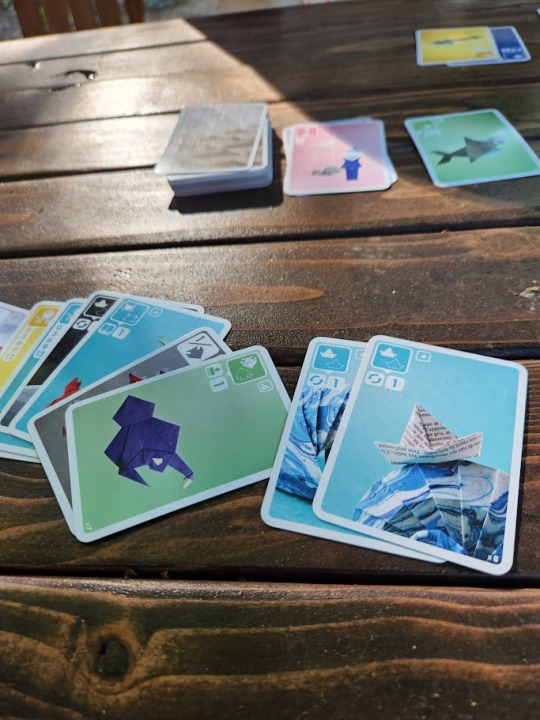
Like many others, we got addicted to Sea Salt and Paper on Boardgame Arena - so addicted that I ordered the physical copy from France! This is a small clever card game with whimsical ocean-themed origami art that is quick to learn, smooth to play, and beautiful to look at.
The game is a race to 40 points (in a 2P game). There are a few ways to do this: playing "duos" (pairs of cards which also give you bonus actions), collecting sets of sea creature cards (octopuses, penguins, shells, etc.) or sets of colors if you also have any Mermaid cards. In each hand, the first player to reach at least 7 points can call out "Stop" or "Last Chance" and end the round. If you call stop everyone stops and counts their points immediately. If you call last chance, the other players have one more turn to try to beat your score. If they don't, you get a bonus and they get a penalty.
More rounds follow until one person reaches 40 points and wins.
The cool thing about the BGA digital game is that all the math is done for you. The real life card game is just as much fun but you will need pencil and paper to keep track of scores or download a score counter app for your phone.
2. Spots
Designer: Alex Hague, Jon Perry, Justin Vickers Publisher: CMYK
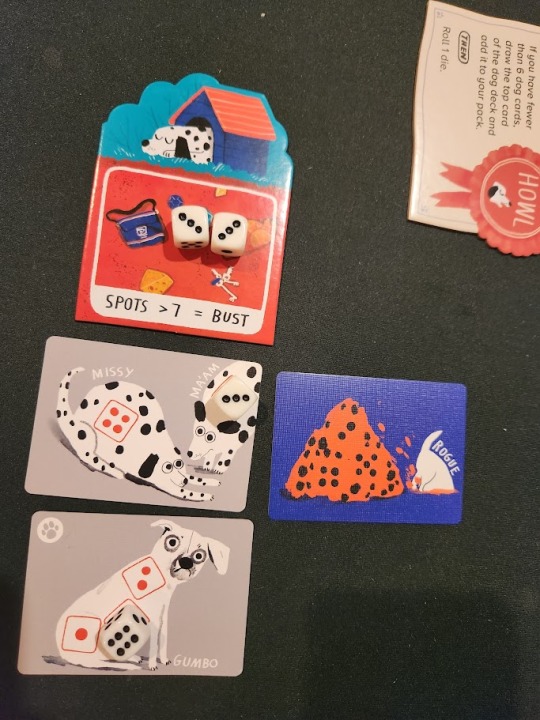
Spots is a cute, light push-your-luck dice game that is also on BGA, but much better in its physical form because rolling a handful of dice and placing them on spotty dogs is the fun part. The dog art is SO CUTE (Burt is my favorite!).
Like Sea Salt and Paper, Spots is also a race. Each game starts by selecting a set of six action cards, each with a different way you're allowed to roll your dice, and drawing two dog cards, which have empty dice spots on them. On your turn, you pick one of the six actions that haven't already been picked by a previous player, and follow its rule, which is usually about letting you roll a certain number of dice, or earning a "treat" (bone) or drawing another dog card. If any of the numbers on your rolled dice match the numbers on any of your dogs, you can put them on that dog. If you get a bad roll and nothing fits, you can spend a "treat" to reroll, or end your turn by burying the bad dice into your "yard." Dice points in your yard can't exceed seven or you "bust" - which means you have to remove all the dice from any of your incomplete dog cards and starting again. The first player to completely score six dog cards is the winner.
This is a great game to play with non-gamers. It's simple to teach, and fast to play. The only downside is that it is 100% luck-based so if your dice rolls are crap then it may not be as much fun.
3. Scout
Designer: Kei Kajino Publisher: OINK games
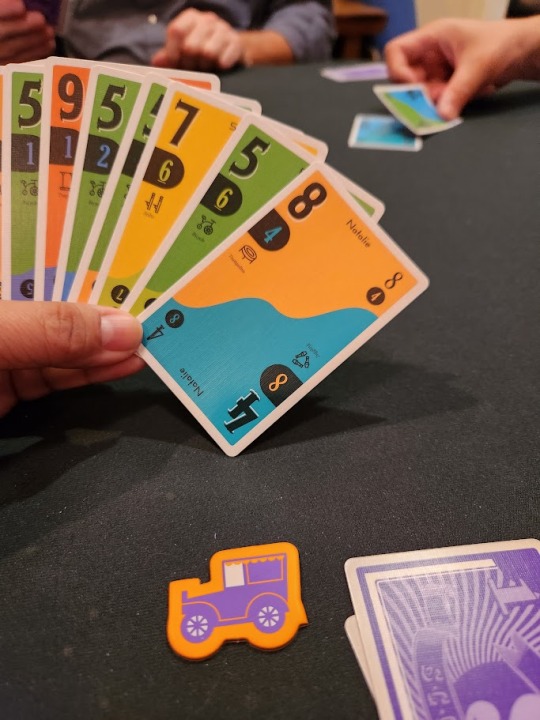
Scout is supposed to be a circus themed card game, but the theme is so understated it took us about three plays before we even noticed. Really, it's a fast and thinky abstract game that keeps you busy planning your next play and paying attention to how many cards your opponents have left. Scout is best with 3 or more players and we have not yet met anyone who doesn't love it after the first play and want to play it again.
The goal of each hand is to be the first player to get rid of all the cards in your hand, and the game lasts the same number of rounds as there are players. On your turn you must play cards of a higher value than the previous card(s) played to the table, and if you can, you get to take the previous cards as points.
But here's where it gets tricky - the cards in your hand must remain in the order as they were dealt to you. You can't reorganize them, and you can only play cards to the table that are adjacent to each other.
If you can't beat the previous cards, you can "scout," which lets you take a card from the ones on the table and place it in your hand. This gives the previous player a point, which is bad, but strategically placing the new card in your hand to make a pair or a run can make your hand better, which is good!
This is the central challenge of the game - figuring out when to take cards, which cards to take to make pairs, triplets, or sequences emerge in your hand that will score you points, and when to play them!
The round ends when one player run out of all their hand cards. Then all players score a point for each card and token they've collected during the hand, then deduct one point for each remaining card in their hand.
It's a fun but brutal game were points can swing fast!
4. Photograph (Wind The Film)
Designer: Takako Takarai Publisher: Matagot, Saashi and Saashi
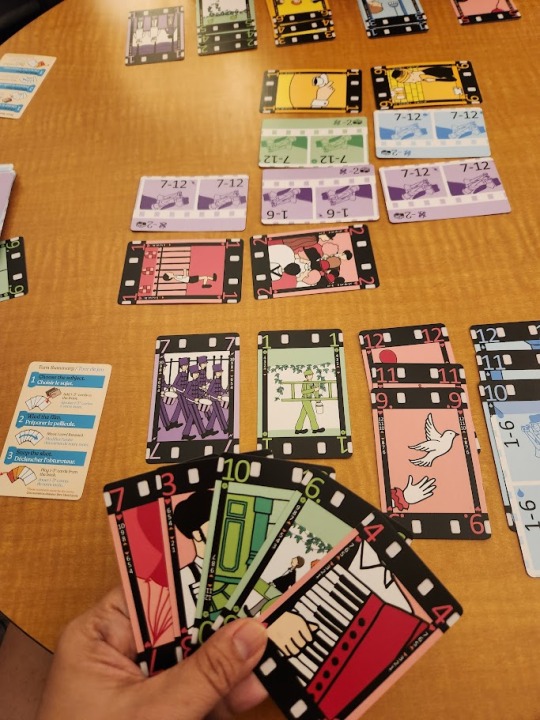
Another charming and harder-than-it-looks card game from Japan where the order of cards in your hand must remain unchanged. On your turn, you take three actions:
Draw 1-3 cards from the table spread and place them in the top/front end of your hand of cards
"Wind the Film" by relocating any ONE card in your hand toward the front
"Snap the shot" by playing the same number of cards that you drew to the table in front of you from the back of your hand.
In this game, you are all trying to create rows of as many cards of the same color as possible - but their numbers must be no more than 3 apart in either ascending or descending order. There is only one card of each color and number in the deck.
At the end of the game, points are scored by the number of cards per color sequence that you have collected. Points are deducted for "failed shots" which are cards with out of sequence numbers. This is a brilliant, brain-twisting little game with whimsical vintage-style illustrations in Saashi and Saashi's trademark style.
5. Mooncake Master
Designer: Daryl Chow Publisher: Origame
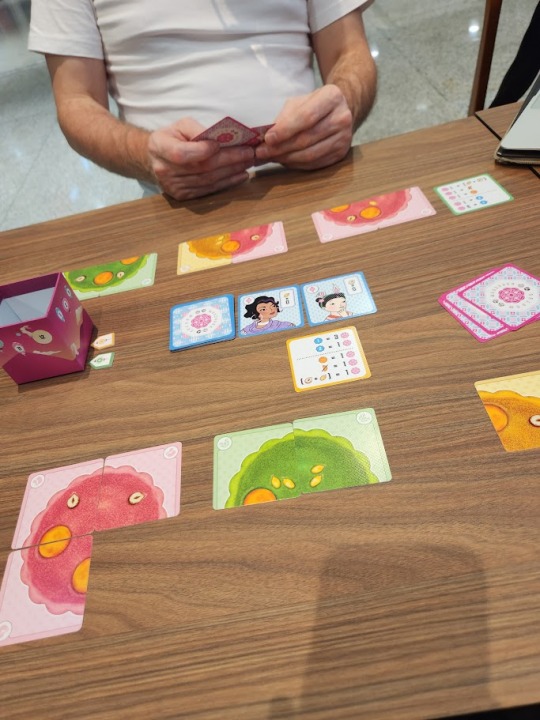
While visiting my family in Singapore, we went to game publisher Origame's warehouse to pick up a copy of Come Sail Away (which was sold out at Essen). While we were there, Daryl Chow, the designer, showed us his other games and oh boy was it hard to choose. I bought "Oh My Orchids" for my aunt (who studied orchids as a botanist), and "Mooncake Master" because it looked cute and the box was small enough to fit in my suitcase.
This is a light game with pretty colors where you draft cards to construct 3 full mooncakes, scoring "flavor points" if you meet certain criteria like "number of full yolks," "no half yolks," "one flavor only," "nuts," etc. The player with the most flavor points earns festive points... which you can also earn if you correctly fulfill a customer's mooncake order. At the end of three rounds (total of 9 mooncakes), the player with the most festive points wins.
6. Harvest
Designer: Yukihito Morikawa Publisher: ForGames
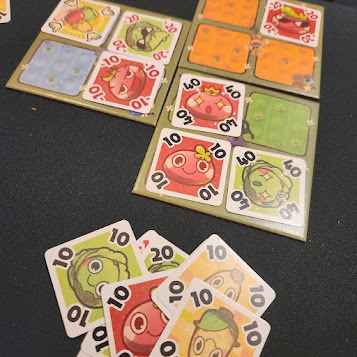
Harvest appears to have been around in Japan since the 1990s and was published by the creator of Pokemon! We were lucky to get a copy from a friend who visited Japan. The English rules can be downloaded online.
This is another light party game that is all "Take That!" Each player has a hand of vegetable cards, which can have either positive or negative points, and a "field" of 4 spaces onto which they can plant them. If there's already a vegetable in their field, they can plant a card on another player's field instead. Usually the negative ones!
Whenever a row of the same three veggies are planted, either orthogonally or diagonally, "Harvesting" is triggered, and each player claims the veggie card(s) on their field. Then, at the end of the game, players add up and subtract the points on their harvested cards, and the uighest number of points wins!
It's a simple, fast, fun, but also a naturally mean game. There is nothing more enjoyable than playing veggies with negative points on someone else's field so you can avoid harvesting those negative points yourself!
0 notes
Text
Dune Imperium
Designer: Paul Dennan Publisher: Direwolf Digital Theme: Conflict in the Dune universe

In the past couple of months, we’ve been playing Dune Imperium more than any other game we own.
In spite of not knowing much about the Dune universe (or in Nathan’s case, reading it when he was twelve, then forgetting it completely) and the aesthetics being, uh, dry as a desert (no colorful components or cute meeples!) we really enjoy this tightly-designed worker placement + deck building + slightly asymmetric conflict game that feels satisfyingly chunky and strategic.
Things we love about Dune Imperium:
Doesn’t take long to set up
Simple win condition: first player to reach 10 points wins, and the game ends. (no counting points at the end of the game)
Not being able to predict who is going to win even right up to the last turn!
No dice in the combat phase, which is refreshing! The player with the highest number of “troops” (cubes in the combat area) + “dagger” cards revealed from their hand, wins the combat and its rewards.
You can choose to not enter into specific combats and still have ways to score points or gain resources.
Two-player games use a “dummy” 3rd player with a turn that involves just turning over one card, and which goes really fast. The game does not feel like it lacks anything at a two-player count vs with three players.
Update: We recently added the Rise of Ix expansion, which offers new factions, new cards that grant more powers, and new ways to up your combat advantage, and to gain spice and influence. We love it! It’s one of those rare expansions that really makes the base game better.


0 notes
Text
Cascadia
Designer: Randy Flynn Publisher: Flatout Games Theme: Wildlife & their habitats

We moved house this year and went through a dry spell with board gaming for a couple of months. Then the Kickstarter games that I (Lili) forgot that I backed started arriving and Cascadia was one of these!
Cascadia is two layered tile laying game, where you’re trying to group together different habitats while at the same time trying to group together different kinds of animals. The difficulty is, the habitats and the animals want to be grouped in entirely different ways!
Each turn you pick up 1 animal token (elk, salmon, bear, hawk, fox) and 1 habitat hexagon tile (desert, grasslands, mountain, river, forest) that you place with the other tiles and tokens of your tableau. Grouping the habitats is fairly easy - all you have to do is make sure they’re all touching. But the animals have specific patterns (which change from game to game) that you have to match to get the most points out of them. For instance, all your elk have to be in a straight line, or all your bears have to be in groups of three. Trying to meet both the habitat and the animal criteria at the same time is a fun puzzle.
At the end of the game - triggered when there are no more tiles left - all habitat and animal groups are added up and the highest score wins. It’s a simple, relaxing, fun game that is easy to learn, fast to play.

0 notes
Text
Snow Tails
Designer: Gordon & Fraser Lamont Publisher: Renegade Games Theme: Sled Dog Racing

It’s the night before New Year’s Eve in sunny (but currently rainy) Southern California, and while some of our friends are holidaying in Big Bear or doing wintery activities in other snowy parts of the country, we are staying home with our cats, and playing Snow Tails.
Snow Tails is an easy and fun racing game that comes with several different track options - long, short, twisty, etc. On your turn, you play numbered cards on the huskies that are pulling your sled, or on your sled brake.
You take the total of your husky numbers, subtract the sled brake number and move this number of spaces. Two matching husky numbers means you are moving straight ahead. Two different husky numbers means one husky is pulling harder than the other, and will pull your sled either left or right by the difference between the left-husky number and the right-husky number, which is how you take the curves along the track. Taking curves is tricky! And there are speed limits along the track, and trees! And crevasses!
Should you travel above the speed limit, go off track, or collide with a tree or other sled, you will be penalized with “dent” cards, which reduce the number of cards in your hand that you have to choose from. Makes sense, as a damaged sled would be harder to handle, right?
We imagine Snow Tails would be more fun with 3 or more players, but even with 2, it’s tense and immersive, and you can’t really go wrong when there are dogs. :) We love it!



0 notes
Text
The Loop
Designer: Maxine Rambourg, Theo Riviere Publisher: Pandasaurus Games Theme: Fighting a supervillain & his clones across Time

Look at this game! Look how colorful it is!
But don’t be fooled by the colors and the cartoony drawings by Simon Caruso. The Loop is hard! We are (cooperatively) traveling around a circular board across 6 different eras - Dawn of Time, The Medieval Times, Renaissance, Industrial Age, Globalization Age (now), Age of Robots, and The End Times - racing to complete 4 missions before too many time vortexes happen. Meanwhile, every round, the evil Dr. Faux is dropping more clones of himself in more eras, and the more clones there are in an era, the more red “rift cubes” the purple time machine in the center of the board spits out into adjacent eras, and if you get too many rift cubes in any era, well, that’s how you get vortexes, and if you get four vortexes, then the whole of time and space collapses and the game ends and nobody wants that. So there is always an element of tension, and even if we’ve honed our cube-dropping skills and can efficiently strategize to defeat multiple clones, destroy rifts, and loop our actions, bad luck can still wreck everything.
It’s hard, is what we’re trying to say.
Still, the Loop is a lot of fun even when it’s easy to lose. There is planning required - which action cards to play and in which order. You want to generate green “energy” cubes as often as possible because these can be spent for extra movements or most importantly, to LOOP (ie, “repeat”) played action cards of one suit. Which is the central gimmick of the game.
As long as you have green cubes to spend you can LOOP as often as you like, so scavenging the various eras trying to get a hand of same suited cards is part of the fun of the game.
And it is fun. Even though we’ve played it five or six times and won maybe once, it’s not punishing and disheartening to lose - unlike, say, the Robinson Crusoe game. We still like it and enjoy pulling off the shelf often, particularly when friends come over.


0 notes
Text
Rap Godz
Designers: Omari Akil and Hamu Dennis Publisher: Board Game Brothas Theme: Becoming a successful rap artist

It is so refreshing to see a board game that is not about: 1. Colonizing 2. Trading and Building 3. Fantasy creatures 4. Agriculture
In Rap Godz, you play as young rappers just starting out on the road to success, and the resources you collect as you play your cards are swag, skillz, and streetz - so much cooler than wheat, wood, and stone! The board is a big turntable with faders to mark the rounds and turns, on which you move your cubes to keep track of your swag/skillz/streetz levels, and your victory points take the form of tokens that look like framed bronze, platinum, and gold records, complete with hanging wire on the back. At the end of the game, the player with the most number of records is the winner.
Occasionally you may pick up a red Rap Battle card aka “Beef” card which when played, lets you challenge an opponent to a die roll. The loser transfers some of their swag/skillz/streetz over to the winner of the Beef who gets a red beef cube (which made us think of beef boullion cubes...) The Beef card also gets added to the loser’s career timeline, deducting victory points. You want more beef cubes than your opponents by the end of the game as this wins you more records!
Rap Godz is a fun and funny game, a bit low on strategy and deep mechanics, but with a cool concept, engaging art, and some awesome flavor text. We also love putting on some vintage hip hop (eg, Sugarhill Gang) while we play, which is a nice change from the Nordic Folk Metal we play when we play Raiders of the North Sea. :)


0 notes
Text
Cat Rescue
Designer: Ta-Te Wu Publisher: Chronicle Theme: Getting cats adopted into forever homes

Cat Rescue is a cute and simple co-op game. On your turn you place a kitty card from either your hand or the draw pile onto the board (the shelter) at one end of a row to try to create a set of 3 cards of the same color. As soon as you make a set, the middle card is flipped over to the “Cat Rescue” side, which makes this cat ready for adoption. The whole row is then pushed forward one space. The goal is to push adoptable cats off the board to their forever home, represented by the game box. As there are limitations as to which directions/rows can be pushed on your turn, some strategy is required, and things can get a bit desperate toward the end of the game. If a non-adoptable cat is pushed out, they go into your hand (which represents a foster home) and if you ever have three cats in foster homes the game ends!
At the end of the game you count the number of cats you have placed in the game box which gives you a score for how good a Cat Rescuer you are. We are relieved to say our scores have been pretty good so far.

0 notes
Text
Obsession
Designer: Dan Hallagan Publisher: Kayenta Games Theme: Courtship in Victorian England

Obsession is Jane Austen or Downton Abbey in a board game. In a podcast interview, the designer reminds us that these are two entirely different historical periods in England that shouldn’t be lumped together, and yet it is tempting to do so because of Obsession’s obsession with delightfully snooty Englishness.
Playing as one of four families competing for the affections of the Fairchilds, the wealthiest marriage-eligible brother and sister in Derbyshire, you will need to collect guests (cards) who will boost your wealth and reputation, with which you can then use to buy improvements - gargoyles, a french Garden, a fenced paddock, a smoking room etc. - which make your estate fancier, and which score victory you points during Courtship rounds and at game end.
And these guests are fun to meet! Each card has just enough flavor text to evoke the right mood. There are casual guests and prestige guests who can earn you reputation and wealth, and also scandalous guests who lose you reputation and wealth.
And all guests require “servants” (meeples) to be put into play. This is what makes Obsession so clever as a euro game -- the “resources” you need in order to do all your actions (host activities, build improvements) that earn you benefits (wealth/reputation/more guests/VP) are the Servants. The more prestigious guests may require more than one servant. And servants when expended, cannot be put into service for another 2 turns.
The ultra thematic game mechanics make Obsession fun and engaging to play. For instance, when we played a 3P game last week, our friend kept inviting a “wealthy American heiress” to his estate, because, although she deprived him of his good social standing, she also provided him with 800 pounds every visit. They also had a “gossiping” servant who could make the other players lose a reputation point per round. Scandalous!
If you like chunky euros but wish they had more entertaining themes, then Obsession might just be for you.



0 notes
Text
Forbidden Desert
Designer: Matt Leacock Publisher: Gamewright Theme: Co-op survival and escape from a desert

This week we introduced some friends to our board gaming hobby. We wanted to start with something with a fun theme that was easy to learn, and non-competitive. Forbidden Desert is a great game for that purpose. To quote our friend: “It’s so simple! But there is so much tension!”
We have crash landed in a desert while looking for an ancient flying machine, and our situation is desperate. If the sun isn’t beating down on us and forcing us to drink from our rapidly dwindling supply of water, then sandstorms are burying us in ever-shifting dunes, and if we don’t find the parts for the flying machine before the sands overwhelm us, we’ll never get out of here alive.
Each of us has different special abilities (like ‘move diagonally’ or ‘take extra water from wells’) and every turn we each have four actions (any combination of move, clear sand, excavate (flip over a tile), or take one of the four pieces of the flying machine (if one is uncovered). As the tiles shift, and more sand gets added, we have to coordinate our movements to dig our way out and keep each other alive, until we collect all the pieces.
Occasionally the “sun beats down” which forces us to take another drink from our canteens. When the “Storm picks up”, more tiles shift, and more sand is added. Should one player die of dehydration or we run out of sand pieces to add, the game is over, and we lose - which we did twice that night, and which we thought might discourage our friends - but they seemed to really enjoy the whole experience, so we’re counting that as a win.
Though it’s fun, Forbidden Desert is also a very luck-based game. It’s all in the cards. In some games we’ve found the treasure locations really fast, and won really easily. In others it’s seemed impossible to clear the sand and we feel doomed right from the start.
Nonetheless, it’s a great light game that we still pull off the shelf occasionally when we’re looking for something light and quick, and for when we have friends over that we want to introduce to the hobby.


0 notes
Text
Shanghai Noir
Designer: Nathan Long Publisher: N/A Theme: Leaving Shanghai on the eve of WW2.
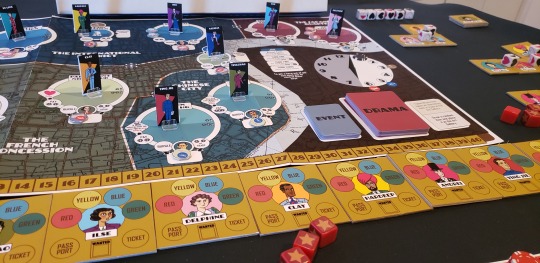
The 2020 pandemic not only had us buying and playing more board games, it also gave a big boost to Nathan’s board game designing hobby. Thanks to Tabletop Simulator (TTS), the processes of making the game components, playtesting, and rules-editing could all be done virtually without leaving home.
Nathan’s game Shanghai Noir takes place on August 12th, 1937 the night before the Japanese invasion of Shanghai - a politically-divided, gangster-ridden, cosmopolitan Chinese city run by money hungry European colonizers. Within this Casablanca-esque setting, players move “heroes” around the game board, picking up passports and travel documents so they can catch the last train, boat, and plane out of Shanghai before 6 rounds (6 hours) are up. But the best way to win points is to resolve “Drama” cards that involve changing relationships between heroes - making them friends, rivals, enemies or soulmates.
What’s interesting is that you do not play as the heroes. You are competing “Fates,” controlling the actions and connections of specific heroes on your turn, while another player may have very different plans for those same heroes on their turn.
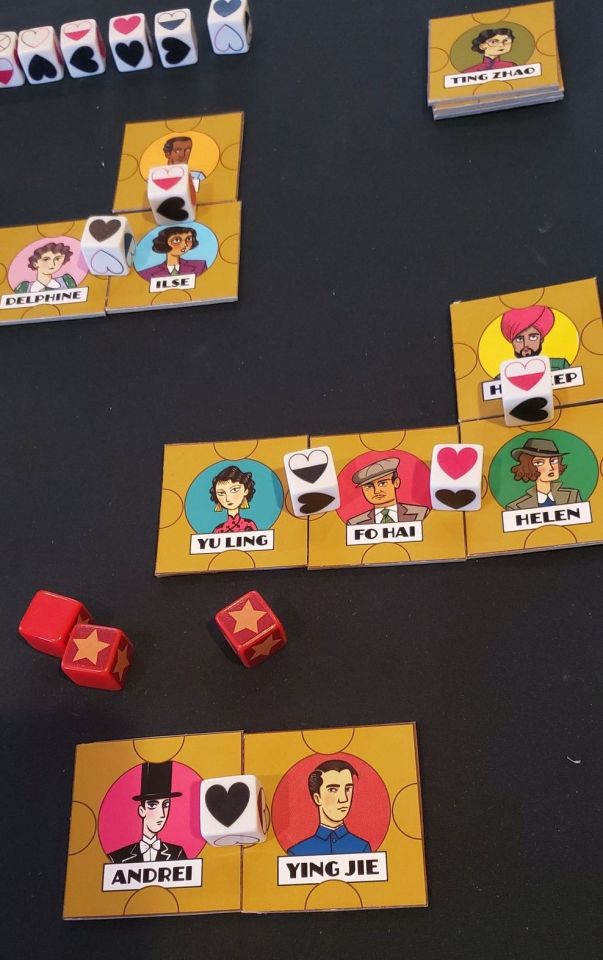
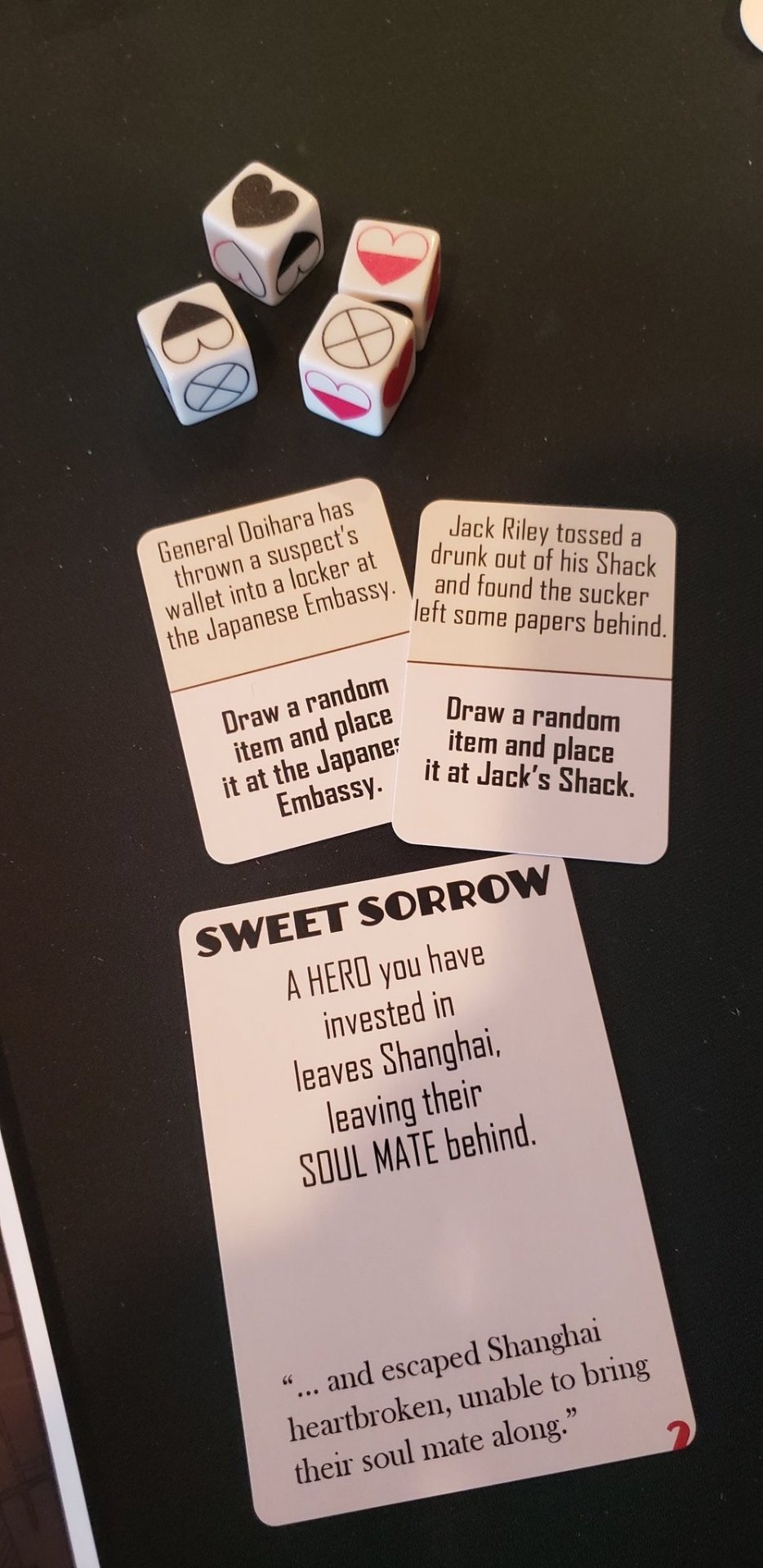
REFERENCE MATERIAL & INSPIRATION:
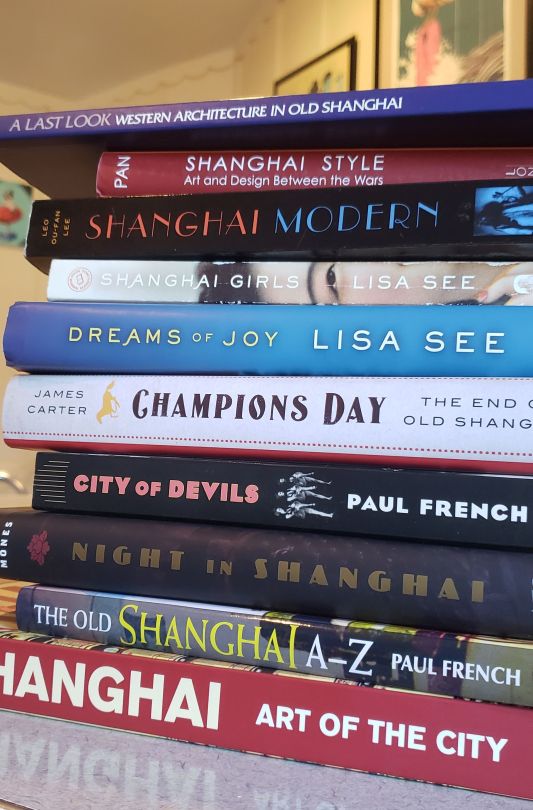
We enjoyed books by Paul French, Lisa See, and any material we could find on the Shanghai Art Deco style which we love. We also watched Chinese and English-language movies set in that time period (“Shanghai”, “Shanghai Triad”, “Empire of The Sun”, “Lust Caution”, “The White Countess”) plus lots of documentaries. There are authentic Shanghai pre-war films on YouTube which are aesthetically more interesting but also intensely bleak. It was hard to find stories that reflected the broad cosmopolitanism of this "Paris of The East”, but hopefully this game captures some of that mood with the characters and locations.
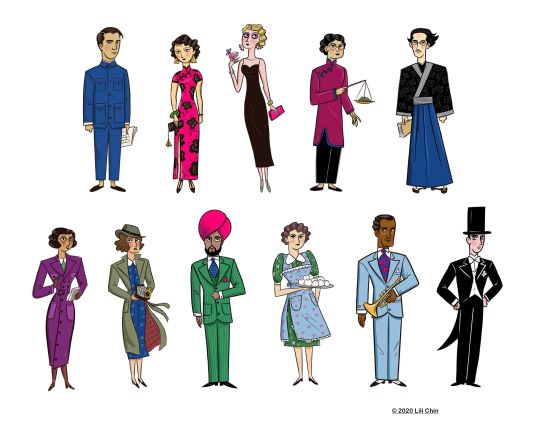
ILLUSTRATIONS:
Lili illustrated all the heroes and villains in this development version of Shanghai Noir. They are American, British, Chinese, French, Japanese, Jewish, Russian and Sikh, some of whom are based on real personalities of Old Shanghai. The locations (based on real places) will also be illustrated and added to the game board at some point. *The final published version of Shanghai Noir may be illustrated by a different artist.
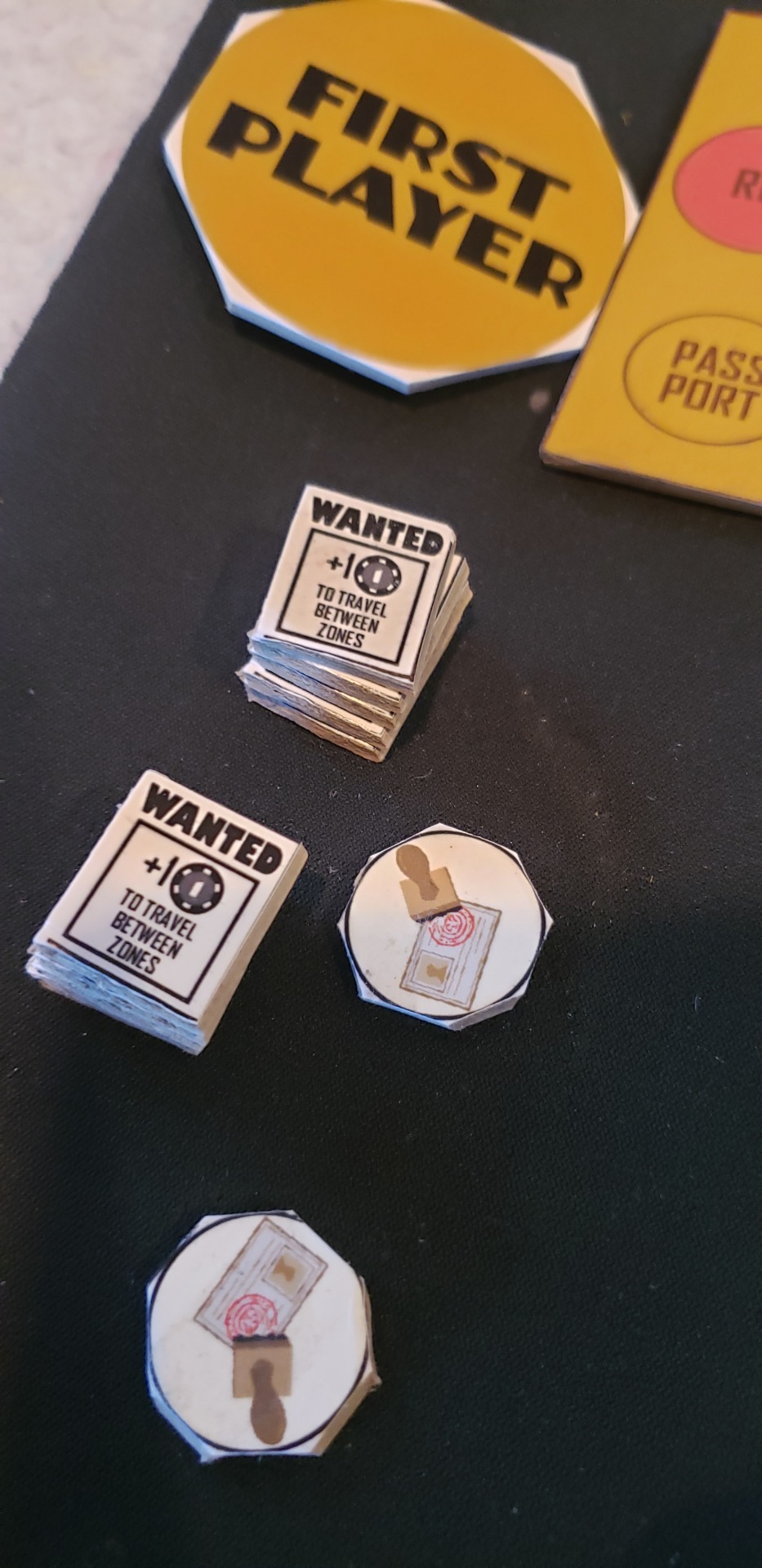
PLAYTESTING:
Shanghai Noir is still undergoing playtesting, and the rules are still being tweaked. Nathan recently made a physical prototype for real life play tests, and the Tabletop Simulator and Tabletop Playground versions also get updated as rules change.
If you are a board gamer/designer/publisher and are interested in playing Shanghai Noir, contact Nathan on twitter or email.
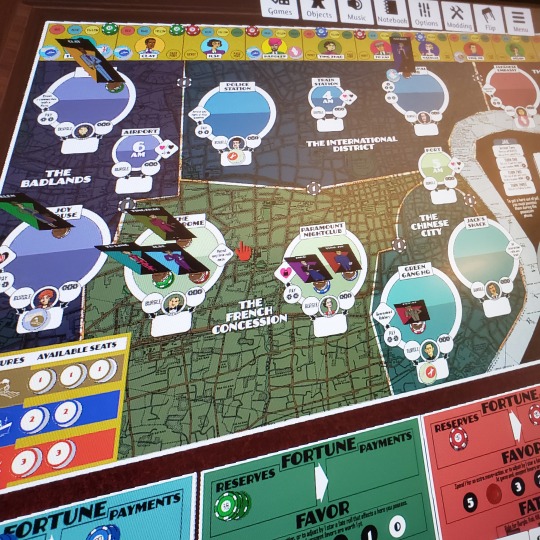
[early TTS version]
3 notes
·
View notes
Text
Mahjong (HK style)
Is Mahjong a “board game”?

For years we have been wanting to play mahjong but could never find two other players who knew the game. Mahjong needs 4 players, no more, no less. There are a couple of good ipad app versions (this is what Nathan plays), but the fun of Mahjong is the social element and the tactile-ness of those chunky tiles. Even building the Wall is an adventure in dexterity.
Last month we got lucky. We were introduced to Madam Ling’s - a small Hong Kong Style Mahjong club here in the San Gabriel Valley that meets up twice a month. Yep, we are going to Mahjong School and we now have 2 other friends to learn and play with! Last week we dragged out the square table and one of Nathan’s five sets of mahjong tiles, and played a full four-hour game at home. It was a lot of fun!
Assuming you have learned to read numbers (from 1 to 9) and the four seasons in Chinese, the game-play in Mahjong is fairly straightforward - you are collecting sets of 3 matching tiles ("pong”), or 3 sequential tiles (”chow”). The first person to get 4 sets of 3 tiles and the “eyes” (any matched pair of tiles) reveals their full hand and calls out "Mahjong” as the winner.
Scoring in Mahjong is the complicated part. Different set patterns yield different points. There are also bonus points that come with having “Wind” and “Flower” tiles that match your seat position. And your seat position changes four times in each round as the dealer (starting player) seat moves counter-clockwise around the table. And since there are four rounds of four deals each, that’s a total of 16 games and a lot of seat positions to remember! I don’t know how expert mahjong players keep track of it all.
Despite all that, the flow of play is smooth and quick as you draw tiles from the wall and discard other tiles back to the table while trying to build your hand, and the whole experience is lovely social and tactile fun.

[photo by Becki Px]
0 notes
Text
New home, new games

From TOP ROW L-R:
The Loop
Summoner Wars
Rap Godz
MahJong (Hong Kong style) - we are going to a Mahjong club and taking lessons! If you are in Los Angeles and are interested in learning, we can hook you up :)
Fort
Cascadia
Kanban EV
Micro Macro Crime City
Shanghai Noir - this is a game that Nathan is designing (character illustrations by Lili) and is on Tabletop Simulator for playtesting.
Cat Rescue - the designer, Ta-Te Wu is our neighbor and now we can have 3P game nights :)
Reviews to come!
0 notes
Text
Venice
Designer: Andrei Novac, Dávid Turczi Publisher: Braincrack Games Theme: 16th century Venice

I (Lili) backed the Venice Kickstarter, mesmerized by the miniature gondolas and Rialto-style bridges. There are also meeples who stand on the gondolas which you then move around the board to pick up cubes (ceramics, cloth, silver) to deliver to specified location for points. You can also place assistants (different meeples) on the locations to gain cubes and benefits from them every time you pass.
As you move and stop along the canals, your movement may cost money, and should you pass another player’s gondola, both of you acquire “intrigue”, which can help you in the short term, but is a bad thing at the end of the game, as an excess of it could have you you arrested ( and eliminated from the game!) by the Spanish Inquisition, which is a surprising mechanic. Nobody expects the Spanish Inquisition.
This week we played Venice for the first time with 3 players. It was nice to not have to use dummy meeples and gondolas as required in a 2 player game, but it made the board feel crowded. Hard to imagine what it’s like to play with four players.
Venice is a beautiful-looking game and we have fun with it, but there are many impracticalities and frustrations. It is extremely fiddly to play with adult-sized fingers. Putting in and taking out your cubes & meeples from the gondolas is a clumsy process; and our gondoliers frequently pitched head-first into the water. We also found ourselves constantly picking up our assistants so that we could read the tiles, because they were standing directly on top of the information we needed to plan our moves. The game could have used a bit more design iteration.


0 notes